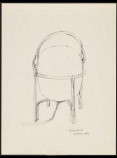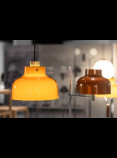(Pre)industrial design

Draw of Cestita lamp. Miguel Milá, 1962.

‘When I got my start, everything had to be designed from scratch’
In the 1950s, there was hardly any modern furniture in Spain to arrange a house, but that had not always been the case. During the Republic (1931-39), architects like Luis Feduchi in Madrid (Capitol building) and the members of GATCPAC in Barcelona had created objects that reflected the doctrines of Germany’s Bauhaus movement.
Milá recalls: ‘There was hardly any industry in Spain when I began to work and design in the 1950s. So, when I was told that what I was doing was design, I knew it couldn't be industrial.’ Perhaps it was not at first, but it soon did become industrial design. In 1956, one of Miguel's aunts, Nuria Sagnier, commissioned him to furnish her studio. One of the standout solutions he came up with was a lamp ‘that could provide both direct and indirect light, illuminate the space and provide light for reading and turn into many lights if it was lowered and the lampshade was raised’. That was the TN lamp, the embryo of the TMC and the TMM, both from 1961, the first major milestone in Milá’s career, and a brief compendium of knowledge applied to industrial design. The popularity of the TN.
In 1957, Milá launched the adult version of his company, Tramo, so he could produce his own creations, pieces designed to fill the gaps he found as an interior designer. He also began to participate in pioneering business initiatives, like Polinax, founded by his brother Leopoldo, and the furniture shop and maker GRES, which was opened by the entrepreneurs Montserrat Tayà, Montserrat Tort and Maria Rosa Ventós in 1958. During those years, Milá designed some of the lasting icons of Spanish industrial design, like the Cesta lamp (1962), the stackable MMS table (1963), ice tongs (1965) and the A14 fireplace (1977).

